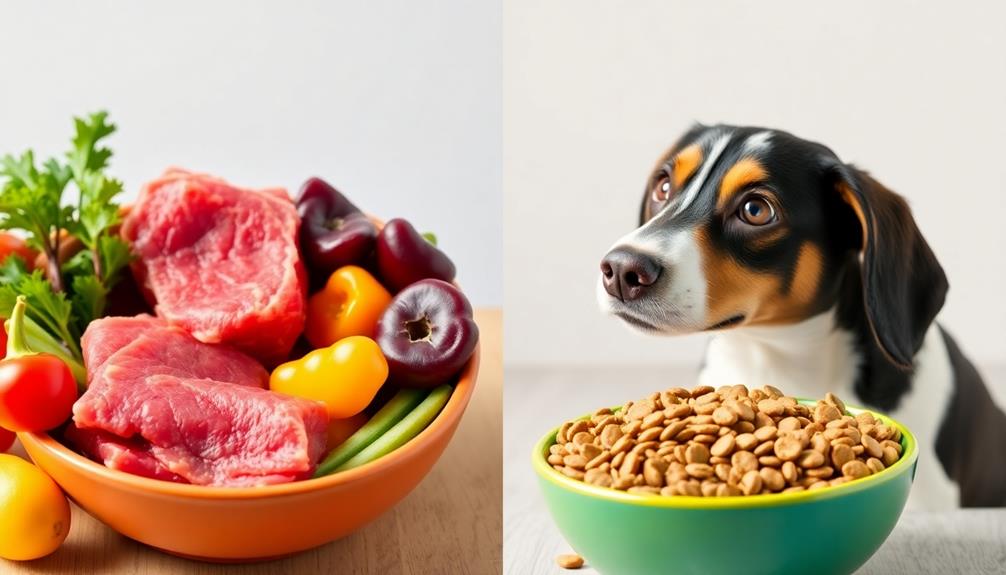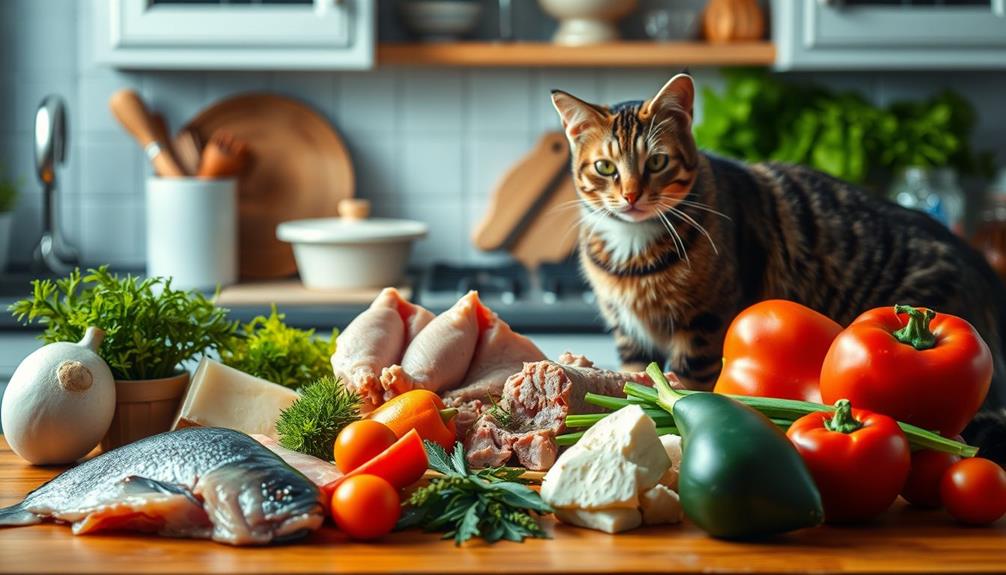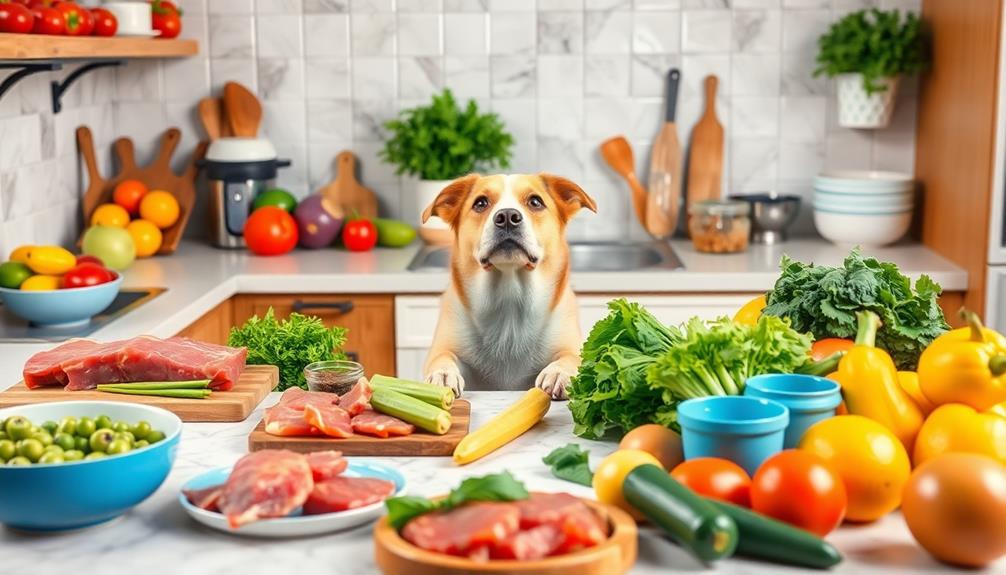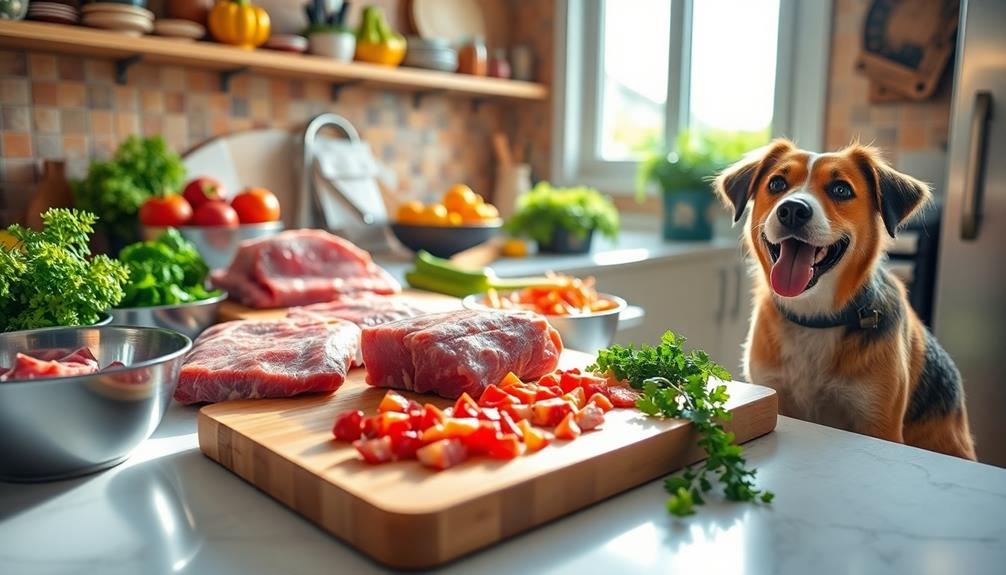Combining raw and kibble can definitely enhance your dog's diet. You get a balanced mix of nutrients, improving overall health and digestion. Raw food adds high-quality proteins and beneficial enzymes, while kibble offers essential vitamins and minerals. Gradually introducing raw food helps minimize digestive upset and supports gut health. Many dogs thrive on this variety, benefiting from potential reductions in allergies and better nutrient absorption. However, it's vital to monitor your dog's response and consult with a vet for safe changes. If you're curious about the best strategies for mixing these diets, you'll find more insights ahead.
Key Takeaways
- Mixing raw and kibble diets can enhance nutritional variety, providing a balanced intake of macronutrients and essential vitamins.
- Gradual introduction of raw food minimizes digestive disturbances and allows gut bacteria to adapt effectively.
- Incorporating raw food can improve nutrient absorption, digestive health, and overall immune function in dogs.
- Combining raw food with kibble can be a cost-effective solution, addressing nutritional gaps while being budget-friendly.
- Monitoring for digestive issues and sourcing quality ingredients are crucial for safely blending raw and kibble diets.
Myths About Mixing Diets
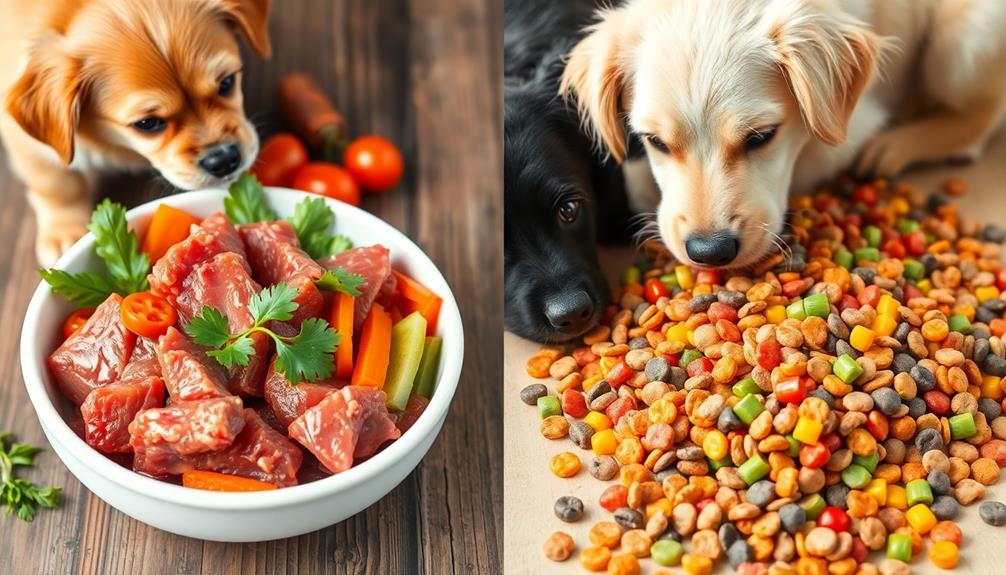
Many dog owners often fall for myths about mixing raw and kibble diets. One common misconception is that combining these food types increases stomach pH, which supposedly hinders protein digestion. In reality, your dog's digestive system processes food based on macronutrients, not the specific types of food.
Another myth suggests that dogs' digestive enzymes can't effectively break down both raw and kibble when mixed. However, studies show that their GI tract can handle various food combinations without any issues.
Some advocates warn that kibble causes digestive disturbances when mixed with raw food. Yet, research indicates that digestive upset usually stems from sudden dietary changes rather than the mix itself.
It's also falsely believed that shifting to a raw food diet must be done exclusively, without any kibble. Gradually incorporating raw food can actually enhance health and provide a balanced nutritional approach.
Ultimately, the idea that dogs can't thrive on mixed diets is unfounded. In fact, many dogs benefit from the variety and nutritional balance achieved by mixing raw and kibble in their meals, leading to improved overall health.
Digestive Health Considerations

Digestive health plays an essential role in how well your dog adapts to a mixed diet of raw and kibble. When you're mixing raw and kibble, it's vital to understand that digestive issues usually stem from sudden dietary changes rather than the combination itself.
A gradual shift allows your dog's gut bacteria to adapt, minimizing the risk of digestive upset and promoting better overall digestive health. Including safe fruits like apples and pears can provide additional fiber and nutrients during this shift, which can support digestive health safe fruits for dogs.
During this shift, you should closely monitor for signs of digestive issues, like irregular stools or discomfort. This vigilance helps guarantee that your dog adjusts smoothly to the new diet.
Incorporating probiotics can also be beneficial, as they help maintain a healthy balance of gut flora, mitigating potential disturbances that might arise when mixing food types.
Strategies for Combining Foods
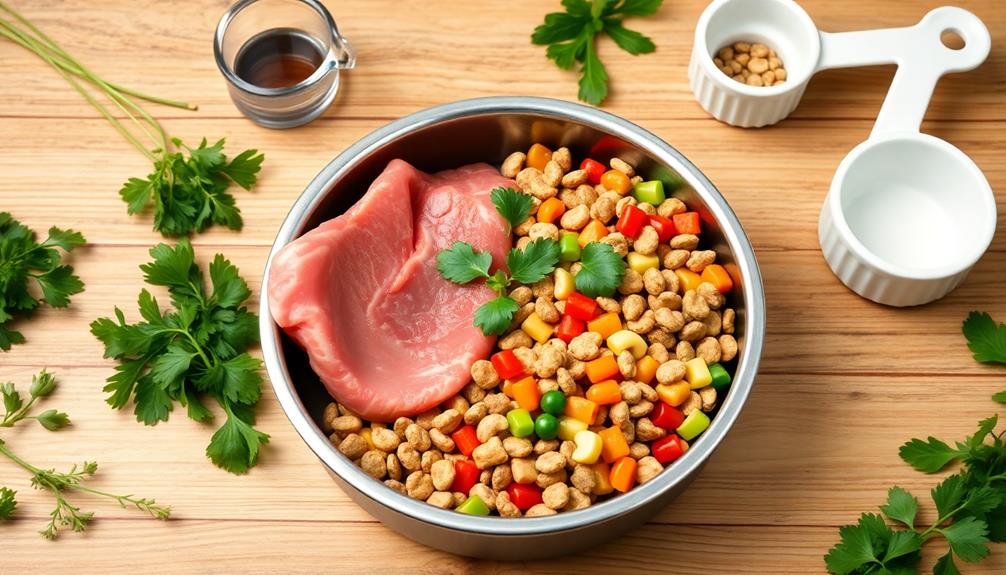
How can you effectively combine raw and kibble in your dog's diet? One of the simplest strategies is to use raw food as a topper for kibble. This method enhances palatability and nutrition without needing a complete dietary overhaul. Additionally, incorporating proper diet guidelines can help guarantee that your dog receives a balanced mix of nutrients.
Alternatively, you can alternate between raw and kibble meals throughout the day. This approach not only adds variety but also helps manage food supplies effectively.
When introducing raw food, take it slow. Gradually mix it in over 4-6 days to allow your dog's digestive system to adjust, minimizing the risk of an upset stomach. It's essential to tailor meal plans to your dog's specific needs, considering factors like age, size, and activity level, as well as any existing health concerns.
While feeding your dog, keep an eye on their response. Monitoring their tolerance during this change can help guarantee a successful combination of raw and kibble diets. Adjust the ratios or types of food as needed to support their overall health and well-being.
Nutritional Benefits of Mixing
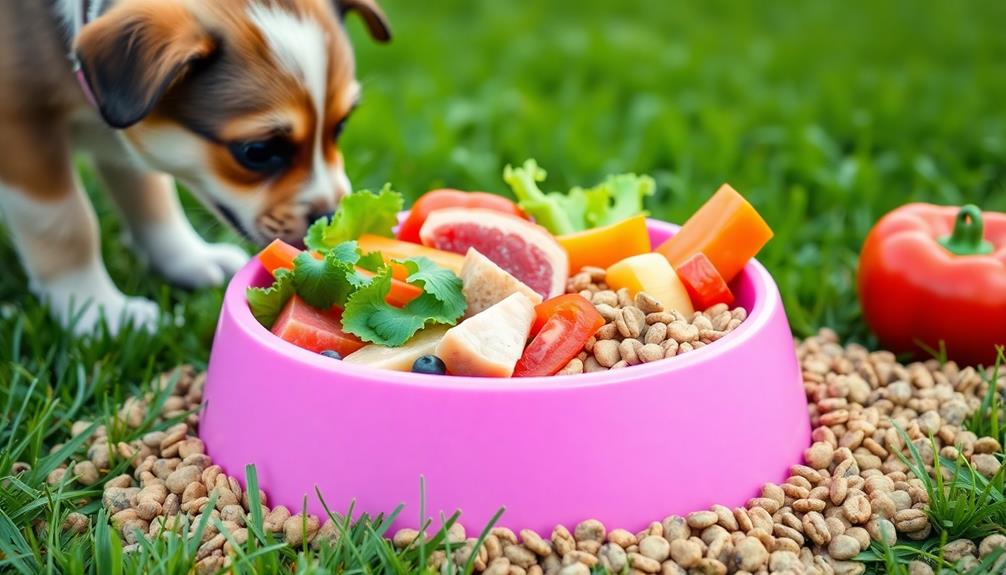
Mixing raw food with kibble gives your dog a balanced nutritional profile that supports overall health.
You'll notice enhanced digestive health and better nutrient absorption, thanks to the high-quality ingredients in raw food.
Plus, this approach can be a cost-effective feeding solution, allowing you to provide variety without breaking the bank.
Balanced Nutritional Profile
Combining raw food with kibble can greatly boost your dog's nutritional intake by offering a diverse array of macronutrients. A raw diet is rich in high-quality proteins and fats, while a kibble diet typically contains essential vitamins and minerals. Even a small inclusion of raw food—just 10%—can considerably enhance your dog's meals, thanks to the natural enzymes and nutrients that help boost immunity and reduce allergies.
High-quality kibble is designed to meet complete nutritional standards, filling any gaps that may arise from a homemade raw diet. This balanced nutritional profile guarantees your dog gets all the essential nutrients they need.
Furthermore, mixing raw food with kibble allows you to customize your dog's meals based on their specific health needs, age, and activity level, providing dietary flexibility.
The convenience of combining these two types of pet food also offers a cost-effective solution for pet owners, helping you manage food budgets while delivering a nutrient-rich diet.
Enhanced Digestive Health
Integrating raw food with kibble not only enhances your dog's nutritional profile but also greatly boosts their digestive health. When you mix these two types of food, you're introducing high-quality proteins and enzymes from raw food that improve nutrient absorption and digestion.
Even adding just 10% raw food to your dog's meal can notably enhance their digestive health, reduce allergies, and strengthen their immune function.
Gradually introducing raw food allows your dog's gut bacteria to adjust, minimizing the risk of gastrointestinal upset during dietary changes. Since dogs' digestive systems are well-equipped to handle mixed diets, finding the right ratios can lead to ideal nutrient utilization and overall gut health.
High-quality kibble is designed to meet essential nutrient needs, but mixing it with raw food fills any nutritional gaps, ensuring your furry friend receives a balanced diet.
Cost-Effective Feeding Solution
A cost-effective feeding solution for your dog lies in the nutritional benefits of mixing raw food with high-quality kibble. By combining these two types of food, you can create a balanced diet that addresses any nutritional gaps that might occur if you only feed one type.
Feeding raw food offers essential nutrients and improved digestibility, while kibble is often more budget-friendly, allowing you to manage food costs effectively. Additionally, choosing high-quality kibble can provide a solid foundation of nutrition, as many vet-approved brands are designed to support overall health and wellness in dogs, including options for best dog food for allergies.
When you incorporate kibble into a raw diet, you can enjoy the health benefits of raw food without the financial strain of exclusively feeding raw. This mixed approach not only helps you save money, but it also enhances palatability, making meals more appealing for picky eaters.
Using kibble as a base for raw food can encourage your dog to consume a varied and nutritious diet. By mixing kibble and raw, you guarantee that your furry friend receives all the necessary nutrients while keeping your budget in check.
Ultimately, this balanced feeding strategy provides an excellent way to meet your dog's dietary needs without compromising on quality or breaking the bank.
Safety Precautions to Follow
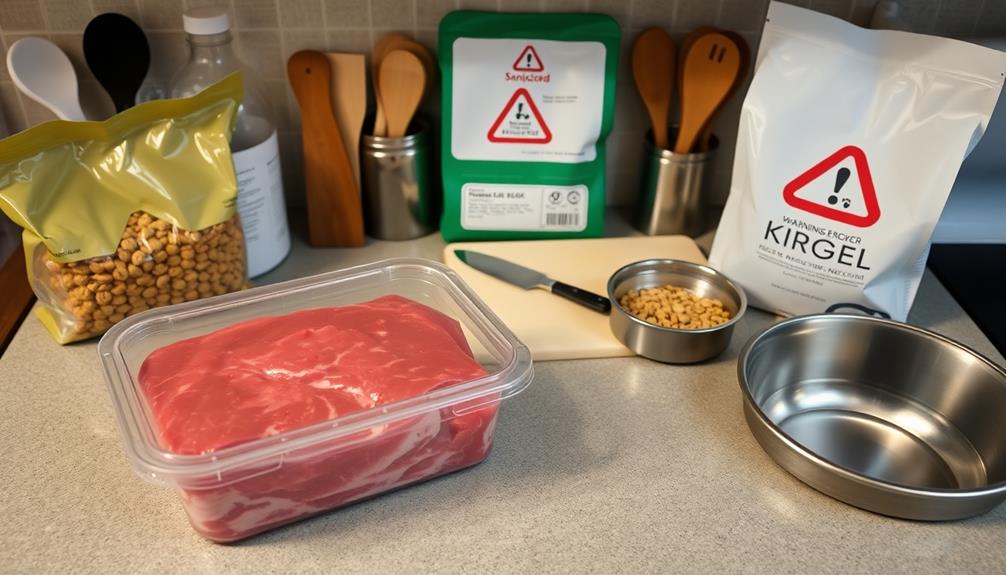
When mixing raw food with kibble, it's important to follow safety precautions to guarantee your dog's health. Start by gradually introducing raw food into your dog's diet over 4-6 days. This allows their digestive system to adapt and minimizes the risk of gastrointestinal upset.
During the change process, monitor your dog for any signs of digestive disturbances, such as irregular stools or discomfort. If you notice anything unusual, it's necessary to consult with a veterinarian for personalized advice on dietary ratios and specific needs.
Make sure to source raw food from reputable suppliers to avoid contamination and reduce the risk of foodborne illnesses. Practicing good hygiene is also important; clean feeding areas and utensils regularly to prevent the spread of bacteria when mixing raw and kibble diets.
This not only protects your dog but also keeps your home environment safe. By taking these safety precautions seriously, you can help guarantee that your dog enjoys the benefits of a mixed diet without compromising their health.
Long-term Health Impacts
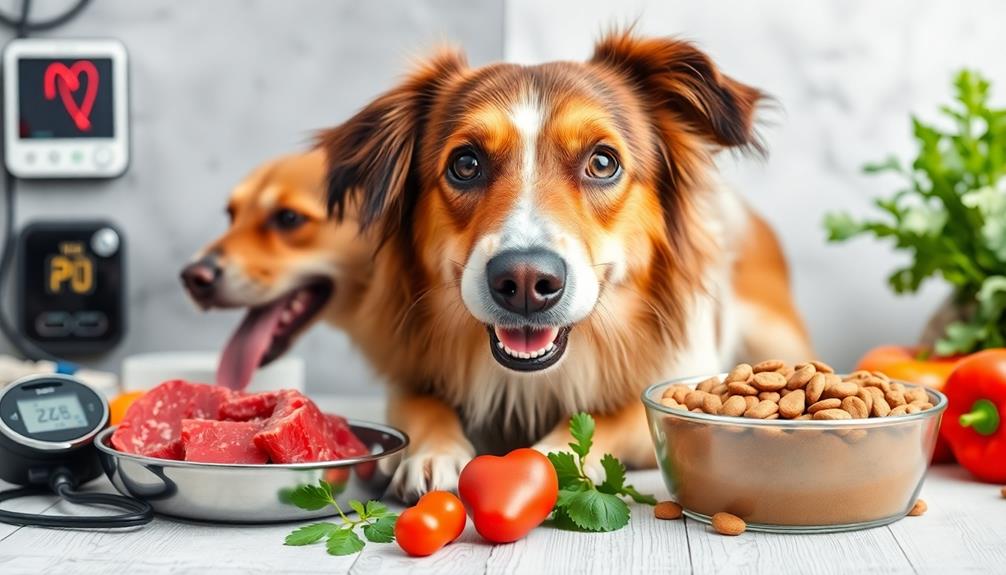
When you mix raw food with kibble, you'll likely notice improved nutrient absorption in your dog.
This means they're not just getting calories, but also the essential vitamins and minerals they need for long-term health.
Plus, this balanced approach can help with weight management, reducing the risk of obesity-related health issues.
Nutrient Absorption Efficiency
Mixing raw food with kibble can greatly boost nutrient absorption efficiency, offering long-term health benefits for your dog. The high moisture and nutrient density of raw food notably improve digestion, helping your dog better utilize the nutrients found in kibble.
Raw foods are rich in essential digestive enzymes and probiotics that enhance gut health, leading to improved absorption of vitamins and minerals.
When you combine the high-quality protein from raw food with the carbohydrates in kibble, you create a balanced amino acid profile that supports muscle maintenance and overall wellness.
Studies have shown that dogs on a mixed diet often experience improved energy levels and vitality, indicating that enhanced nutrient absorption can lead to better long-term health outcomes.
It's important to introduce raw food gradually alongside kibble to allow for adaptive changes in gut flora. This approach optimizes nutrient absorption and reduces the risk of digestive disturbances, ensuring your dog reaps the maximum benefits from both types of food.
Weight Management Benefits
Combining raw food with kibble offers significant weight management benefits, helping you maintain your dog's healthy body condition. This blend supports a balanced dogs diet, allowing for better portion control and preventing overeating. Raw food typically contains fewer calories and higher moisture content, making it an excellent addition to your dog's meals.
| Component | Raw Food | Kibble |
|---|---|---|
| Calories | Lower | Higher |
| Protein Content | Higher | Varies |
| Moisture Content | High | Low |
The higher protein content in raw diets promotes muscle maintenance while reducing body fat, essential for effective weight management. By incorporating raw food, you can enhance your dog's satiety, which helps them feel full longer and reduces the risk of obesity.
Long-term strategies that include a mix of raw and kibble can lead to improved metabolic health, minimizing the chances of weight-related issues like diabetes and joint problems. Ultimately, this combination can help you guarantee your dog stays fit and healthy for years to come.
Frequently Asked Questions
Is It Okay to Mix Raw Dog Food With Kibble?
Yes, it's okay to mix raw dog food with kibble. Just introduce it gradually to avoid digestive upset. Monitor your dog's response and consult your vet for the best dietary approach tailored to their needs.
Can I Feed My Dog Kibble in the Morning and Raw at Night?
"Variety's the spice of life." You can feed your dog kibble in the morning and raw at night. Just monitor how they respond, and gradually introduce the raw to guarantee a smooth shift and digestion.
Can I Mix Fresh Food With Kibble?
Yes, you can mix fresh food with kibble. Start gradually to see how your dog adjusts. This combination can enhance flavor and provide extra nutrients, benefiting your dog's overall health and digestion. Monitor their response closely.
How Do You Feed 50% Raw and 50% Kibble?
To feed your dog a 50% raw and 50% kibble diet, measure equal portions based on caloric needs, shift gradually over 4-6 days, and monitor their health and digestive response closely throughout.
Conclusion
In the end, combining raw and kibble can be a double-edged sword. While it offers nutritional benefits and variety for your pet, you need to take into account digestive health and safety precautions. By keeping an eye on how your pet reacts and following proper strategies, you can strike a healthy balance. Remember, it's not just about feeding; it's about nurturing a happy, thriving companion. With the right approach, you'll be setting the stage for a healthier future.

